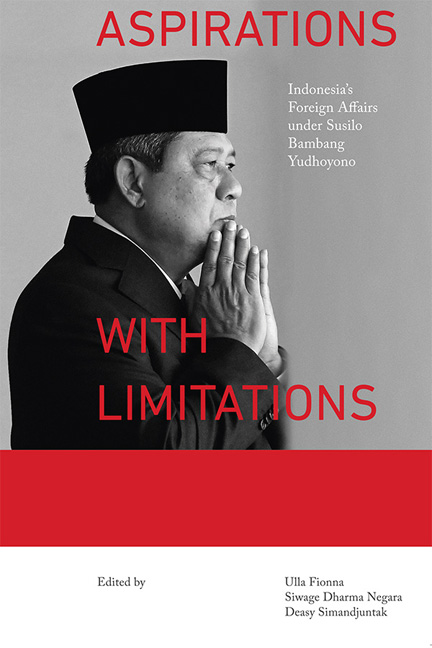Book contents
- Frontmatter
- Contents
- About the Contributors
- 1 Introduction
- 2 Indonesian Foreign Policy: Waging Peace, Stability, and Prosperity
- 3 Indonesia's Diplomatic and Strategic Position under Yudhoyono
- 4 International Economic Cooperation during the Yudhoyono Presidency
- 5 First Term Right, Second Term Shy: A Review of Indonesia's Economic Links with Key Trading Partners
- 6 International Labour Migration: A Very Mixed Blessing
- 7 Law Enforcement, Prevention, and Deradicalization: How SBY Handled Terrorism
- 8 Drifting towards Dynamic Equilibrium: Indonesia's South China Sea Policy under Yudhoyono
- 9 Uneasy Neighbours: Indonesia–Malaysia Relations under Yudhoyono
- 10 A Fair Dinkum Partnership? Australia–Indonesia Ties during the Yudhoyono Era
- 11 The Aceh Peace Process: Wheeling and Dealing behind Closed Doors
- Index
3 - Indonesia's Diplomatic and Strategic Position under Yudhoyono
Published online by Cambridge University Press: 08 June 2019
- Frontmatter
- Contents
- About the Contributors
- 1 Introduction
- 2 Indonesian Foreign Policy: Waging Peace, Stability, and Prosperity
- 3 Indonesia's Diplomatic and Strategic Position under Yudhoyono
- 4 International Economic Cooperation during the Yudhoyono Presidency
- 5 First Term Right, Second Term Shy: A Review of Indonesia's Economic Links with Key Trading Partners
- 6 International Labour Migration: A Very Mixed Blessing
- 7 Law Enforcement, Prevention, and Deradicalization: How SBY Handled Terrorism
- 8 Drifting towards Dynamic Equilibrium: Indonesia's South China Sea Policy under Yudhoyono
- 9 Uneasy Neighbours: Indonesia–Malaysia Relations under Yudhoyono
- 10 A Fair Dinkum Partnership? Australia–Indonesia Ties during the Yudhoyono Era
- 11 The Aceh Peace Process: Wheeling and Dealing behind Closed Doors
- Index
Summary
President Susilo Bambang Yudhoyono came to office intent on consolidating Indonesia's transition to democracy and raising its profile on the international stage. Through an “all directions foreign policy” emphasizing the pursuit of “a million friends and zero enemies”, he sought to build a web of cooperative relationships that would help Indonesia project greater influence abroad, secure its neighbourhood and attract support for development at home. His foreign policy thus bore shades of both Sukarno's global aspirations and Suharto's low-key focus on regional stability and domestic growth.
Yudhoyono aimed to position Indonesia favourably at multiple levels. Within the Association of Southeast Asian Nations (ASEAN), Yudhoyono sought a return to recognition of Indonesia as primus inter pares. He sought to exert leadership by guiding ASEAN's institutional evolution and mediating among feuding members. In the broader Indo-Pacific, the Yudhoyono administration pursued its goal of “dynamic equilibrium” by staking out a central position among major external powers and seeking to harness them to an inclusive ASEAN- centred regional order that would foster cooperation and prevent dominance by any single state. Globally, Yudhoyono endeavoured to raise Indonesia's profile and clout by positioning it as a bridge state between established and transitional democracies and between the Islamic world and the West.
Meeting these objectives presented real challenges. The Yudhoyono administration struggled to reconcile omnidirectional amity with the friction that often accompanies decisive leadership. When Indonesia's local, regional and global goals came into tension, the administration lacked a clear framework for setting priorities. Unlike the concept of “concentric circles” developed during Suharto's New Order regime (Anwar 2014), Yudhoyono did not give consistent ontological priority to the inner (ASEAN) circle. Indeed, as Yudhoyono cast his gaze beyond the region, questions arose of whether ASEAN had been displaced as the long-espoused “cornerstone” of Indonesian foreign policy.
Indonesia's domestic political transformation created foreign policy opportunities and additional challenges. Democratization helped Indonesia position itself as a leader of ASEAN's institutional reform and contributed to its appeal as a bridge state between liberal and authoritarian states and between Muslim-majority states and the West. However, Indonesia's more progressive foreign policy stirred resentment in some Southeast Asian capitals, and democratization made the policymaking process more complex at home, adding to the difficulty of formulating and implementing neatly calibrated foreign policy strategies.
- Type
- Chapter
- Information
- Aspirations with LimitationsIndonesia's Foreign Affairs under Susilo Bambang Yudhoyono, pp. 33 - 59Publisher: ISEAS–Yusof Ishak InstitutePrint publication year: 2018



